Egyptian-born singer, dancer and actress of Hungarian descent Marika Rökk (1913-2004) was the last film diva of the Ufa. She was an immensely talented musical performer who could tap with the rhythm and vitality of her Hollywood counterpart Eleanor Powell, and switch to balletic movements with the conviction of Cyd Charisse. Her trademark was her Hungarian accent.
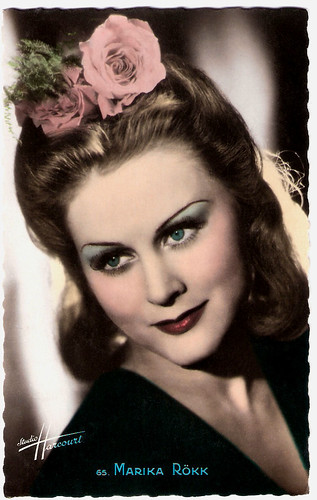
French postcard by SERP, Paris, no. 65. Photo: Studio Harcourt.
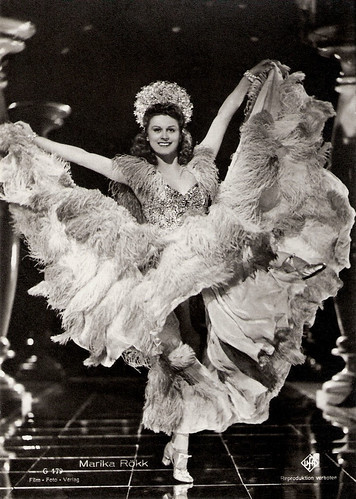
German postcard by Film-Foto-Verlag, no. G 179, 1941-1944. Photo: Ufa.
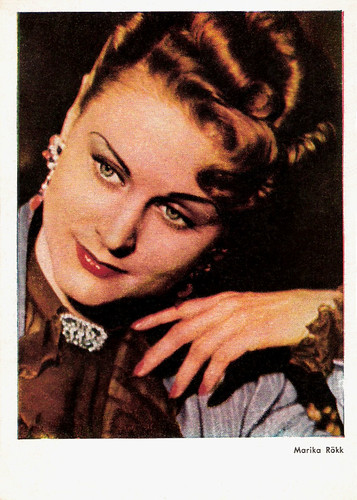
German postcard by Verlag und Druckerei Erwin Preuss, Dresden-Freital, serie 1, no. 11. Photo: Charlott Serda.
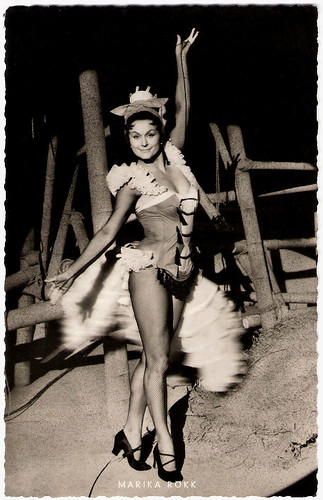
German postcard by Kunst und Bild, Berlin-Charlottenburg, no. B 1547. Photo: Real / Europa / Gabriele.
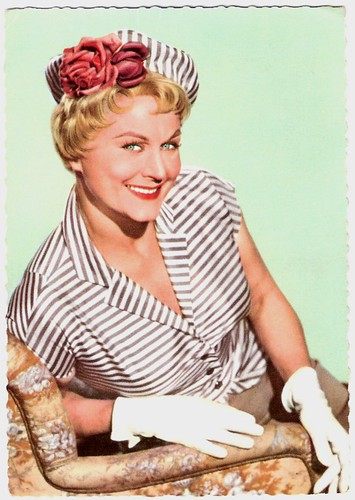
German postcard by UFA, Berlin-Tempelhof, no. CK-167, retail price 30 Pfg. Photo: Joe Niczky / UFA.
Marie Karoline Rökk was born in 1913 in Cairo, Egypt, as the daughter of Hungarian architect and contractor Eduard Rökk and his wife Maria Karoline Charlotte née Karoly.
Marika spent her childhood in Budapest, but in 1924 her family moved to Paris. Here she learned to dance and joined at 13 the Hoffman Ballet Company. With the Hoffmann Girls she appeared even in the Moulin Rouge and on Broadway. After a tour through the US, the Hoffman Ballet Company disbanded.
Marika returned to Europe and her stage career continued to flourish. At the age of 15 she was a star acrobat at the Berlin Wintergarten. She appeared as a revue dancer on the stages of Monte Carlo, Cannes, London, Paris and Budapest.
In England she played in her first film, Why Sailors Leave Home (Monty Banks, 1930) starring Leslie Fuller. It was followed by Kiss Me Sergeant (Monty Banks, 1932).
The Hungarian musical Csokolj meg, edes!/Kiss Me, Darling (Béla Gaál, 1932) was considered her screen breakthrough. After this she made another fine film in Hungary, Kisertetek Vonata/Ghost Train (Lajos Lázár, 1933).
In 1934, when she had a great success in Vienna with the revue Stern der Manege/Stars of the Circus Ring, a talent scout for Universum Film AG (Ufa), Germany's largest production company, offered her a contract, and Marika moved on to Nazi-Germany.
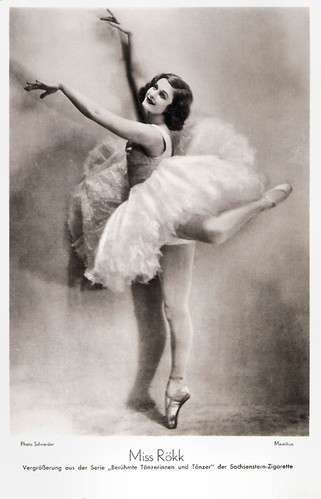
German postcard in the series Berühmte Tänzerinnen und Tänzer for Sachenstern Zigarette by Mauritius. Photo: Schneider.
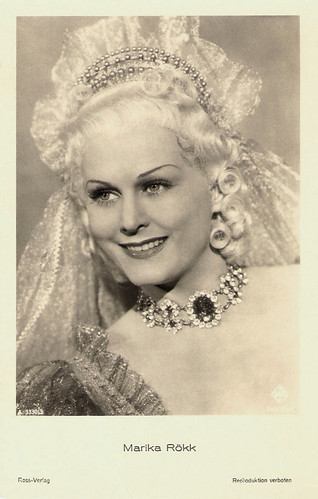
German postcard by Ross-Verlag, no. A 3330/3, 1941-1944. Photo: Quick / Ufa.
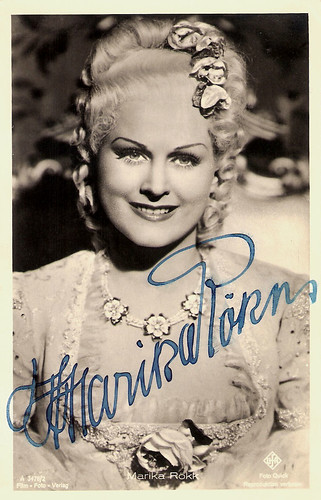
German postcard by Film-Foto-Verlag, no. A 3478/2, 1941-1944. Photo: Ufa / Quick.
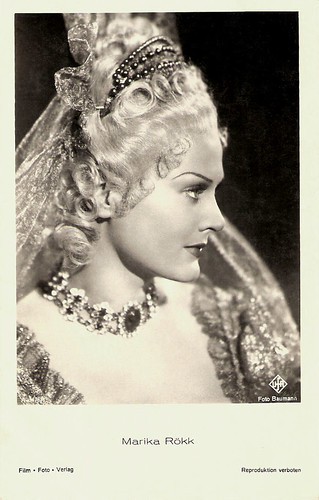
German postcard by Film-Foto-Verlag, no. A 3476/1, 1941-1944. Photo: Baumann / Ufa.
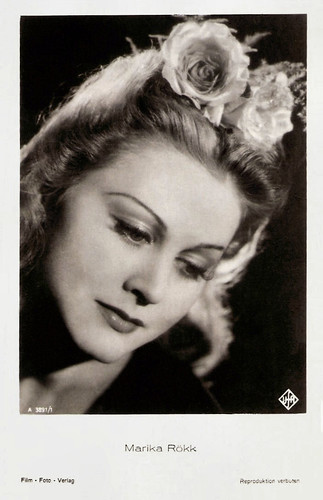
German postcard by Film-Foto-Verlag, no. A 3891/1, 1941-1944. Photo: Ufa.
The Ufa aimed to create a new type of German star, one to rival Hollywood's top musical goddesses. Marika Rökk’s German film debut was Leichte Kavallerie/Light Cavalry (Werner Hochbaum, 1935) with Heinz von Cleve, Ufa’s ‘handsome leading man’.
The film made her a star overnight. It was the first of a series of modern romantic fairy tales, lightweight operettas and glittering revue-style entertainments which quickly made Rökk one of Germany's most popular stars. She had the skill and panache to carry off the often hokey plots and cliched dialogue, and she wore the glamorously designed wardrobes with flair.
Her second German film was an enormously successful adaptation of Karl Millocker's classic operetta of 1882, Der Bettelstudent/The Beggar Student (1936), directed by her husband-to-be, veteran director Georg Jacoby. Handsome Dutch star Johannes Heesters was her co-star and this proved the start of a lucrative onscreen pairing.
Over the next decades, the Traumpaar (Dream pair) would frequently appear together in such efforts as Hallo Janine!/Hello, Janine! (Carl Boese, 1939), Die Czardasfürstin/The Csardas Princess (Georg Jacoby, 1951) and Die Geschiedene Frau/The Divorced Woman (Georg Jacoby, 1953).
However, Heesters called her a Kollegenfresser (partner eater), because of her fierce ambition, fiery temper and iron determination.
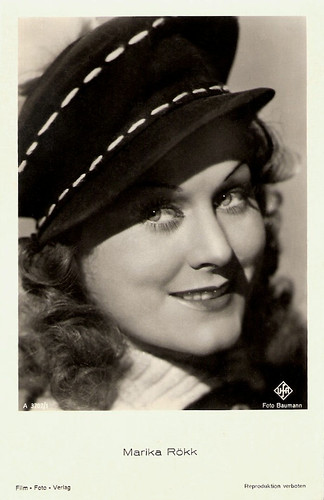
German postcard by Film-Foto-Verlag, no. A 3707/1, 1941-1944. Photo: Baumann / Ufa.
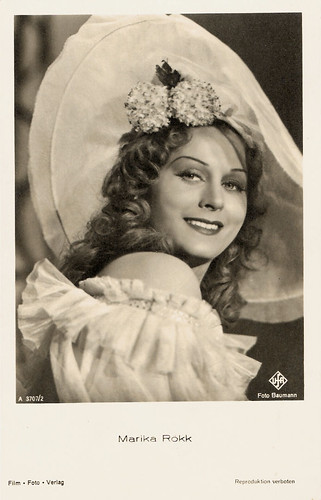
German postcard by Film-Foto-Verlag, no. A 3707/2, 1941-1944. Photo: Baumann / Ufa.
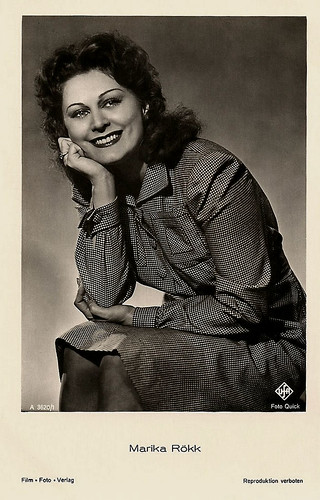
German postcard by Film-Foto-Verlag, no. A 3620/1, 1941-1944. Photo: Quick / Ufa.
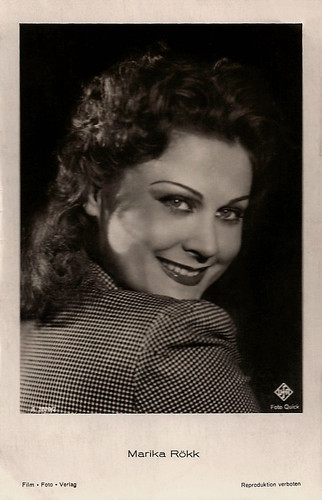
German postcard by Film-Foto-Verlag, no. A 3620/2, 1941-1944. Photo: Quick / Ufa.
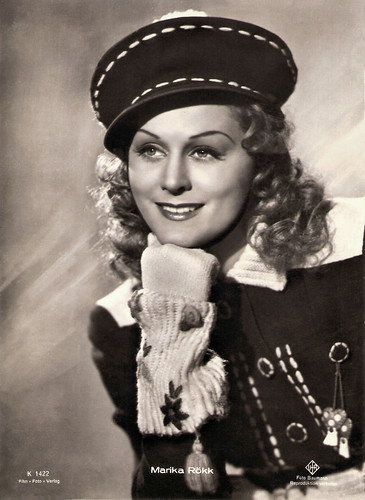
German postcard by Film-Foto-Verlag, no. K 1422. Photo: Baumann / Ufa.
Marika Rökk soon became a leading star of the National Socialist cinema, but her films were also popular in other countries (with Rökk's name often billed as Roekk).
She could count on an experienced team with which she shot most of her musicals and operettas: director Georg Jacoby, cinematographer Konstantin Irmen-Tschet, composers Franz Grothe and Peter Kreuder, and choreographer Sabine Ress.
Her most popular films include Gasparone (Georg Jacoby, 1937) a film adaptation of the famous Franz Lehar operetta, Eine Nacht im Mai/A Night in May (Georg Jacoby, 1938) the first German musical modelled with several lavish production numbers totally in the Hollywood style, and Hallo Janine/Hello, Janine! (Carl Boese, 1939).
In Es war eine rauschende Ballnacht (Georg Jacoby, 1939), she co-starred with that other superstar of the Nazi cinema Zarah Leander.
In another hit, Kora Terry (Georg Jacoby, 1940), she did several dance interludes which were quite revealing at that time.
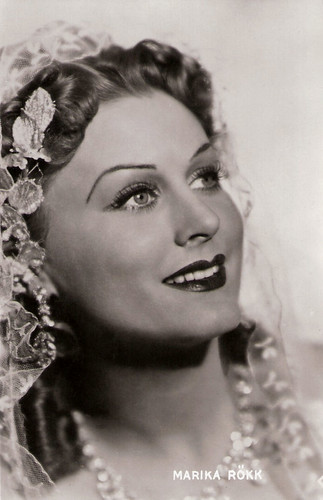
Dutch postcard, no. 41.
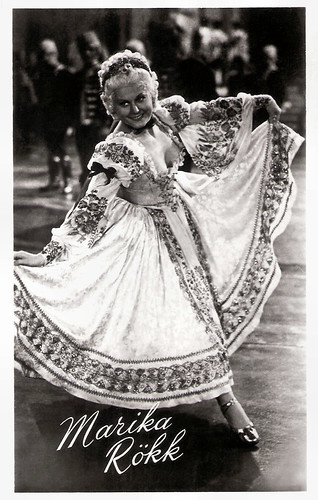
Dutch postcard, no. A x 549.
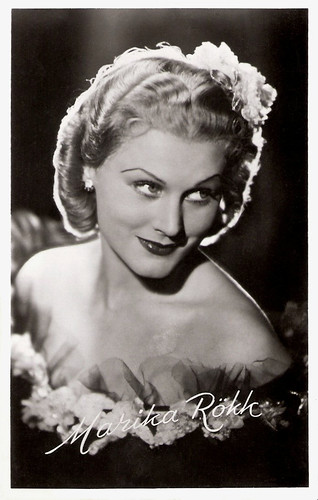
Dutch postcard no. 3466.
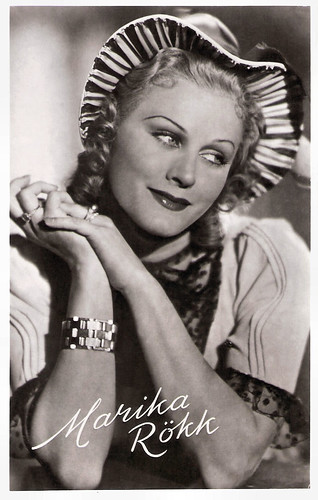
Dutch postcard no. 3468.
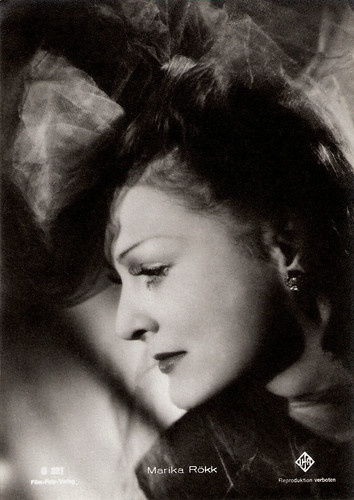
German postcard by Film-Foto-Verlag, no. G 221, 1941-1944. Photo: Ufa.
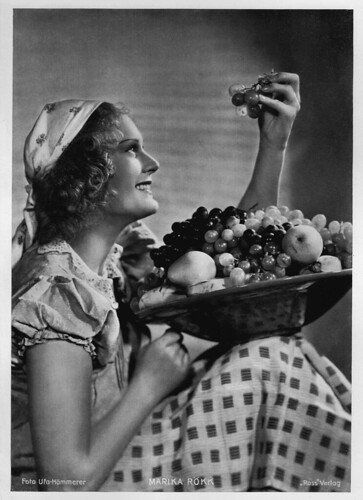
Big German card by Film-Foto-Verlag. Photo: Hämmerer / Ufa.
Again and again Marika Rökk impersonated the at first unrecognised talent, who enforced against all odds and who at the end celebrated her triumphs on stage in a grand final.
Her films were models of escapist cinema, reaching their zenith during the Second World War when they allowed audiences brief respite and access to a carefree world where politics played no role.
In 1941 propaganda minister Joseph Goebbels gave Rökk the leading role in his prestige project, the first Agfacolor motion picture Frauen sind doch bessere Diplomaten/Women Are Better Diplomats (Georg Jacoby, 1941-1943), together with Willy Fritsch.
Her last film under the Nazis was the funny musical Die Frau meiner Träume/Dream Woman (Georg Jacoby, 1944) which holds the record as Germany's top-grossing musical.
After the war she got an Auftrittsverbot (profession ban), but she was rehabilitated in 1947 and could continue her film career. She had been a great favourite of Adolf Hitler, who called her "my little Hungarian". Rökk was even suspected of espionage, but she was rehabilitated. Her husband Georg Jacoby was not allowed to work again till 1950.
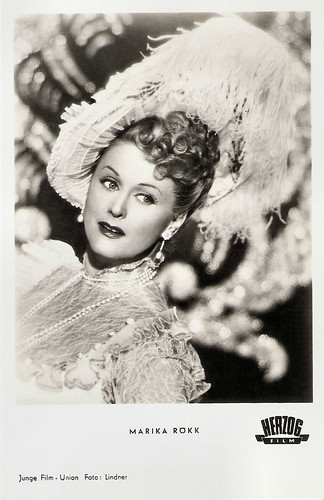
German postcard by Kunst und Bild, Berlin, no. A 478. Photo: Herzog-Film / Junge Film-Union / Lindner. Publicity still for Die Casardasfürstin/The Csardas Princess (Georg Jacoby, 1951).
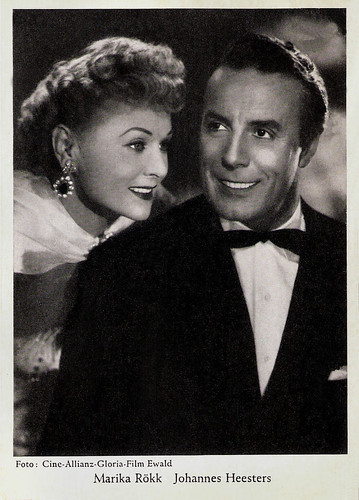
German collectors card. Photo: Cine-Allianz / Gloria / Film Ewald. Publicity still for Die geschiedene Frau/The Divorcée (George Jacoby, 1953) with Johannes Heesters.
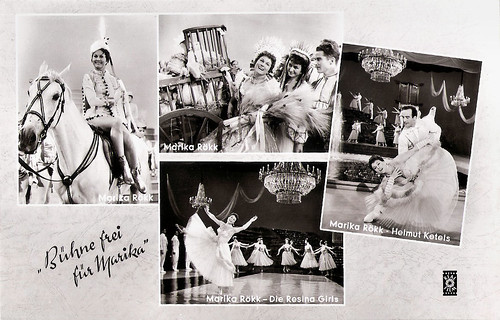
German postcard by Franz Josef Rüdel, Filmpostkartenverlag, Hamburg-Bergedorf, no. M 2484. Photo: Real / Europa / Lantin. Publicity still for Bühne frei für Marika/Stage free for Marika (Georg Jacoby, 1958).
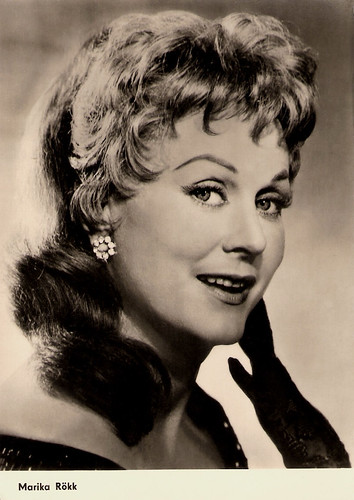
East-German postcard by VEB Progress Film-Vertrieb, Berlin, no. 1747. Photo: publicity still for Bühne frei für Marika/Stage Free for Marika (Georg Jacoby, 1958).
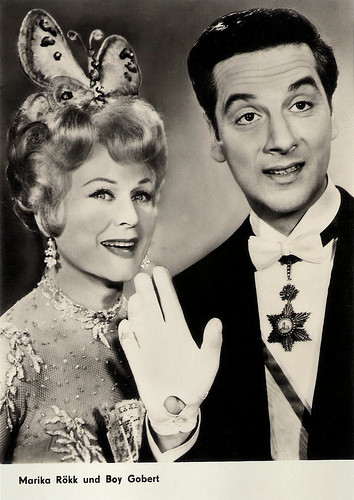
East-German postcard by VEB Progress Film-Vertrieb, Berlin, no. 1849, 1963. Photo: publicity still for Die Fledermaus (Géza von Cziffra, 1962) with Boy Gobert.
After the Second World War Marika Rökk kept dancing. Hungary refused to pardon her wartime career, though she denied collaboration with the Nazis, and she settled in Vienna. During her absence from the screen she entertained the US troops stationed in Germany.
She returned to the cinema with Fregola (Harald Röbbeling, 1949) opposite Rudolf Prack, and made another string of popular, frivolous musicals, including Sensation in San Remo (Georg Jacoby, 1951), as a gym teacher by day who secretly sings and dances in a nightclub at night, and Maske in Blau/Mask in Blue (Georg Jacoby, 1953).
In Nachts im grunen Kakadu/At the Green Cockatoo By Night (Georg Jacoby, 1957) with Dieter Borsche, her school of social graces and dance is about to go bankrupt when she inherits a nightclub. The film proved that there was still an audience for such escapism.
The following year she made her final musical with Jacoby, Buhne frei fur Marika/Stage Free for Marika (Georg Jacoby, 1958). After starring as Adele, the maid, in Die Fledermaus/The Bat (Géza von Cziffra, 1962), she retired from the cinema.
Rökk continued to appear on stage in the theatres in Vienna, Hamburg, Munich and especially Berlin. She performed in revues, musicals and operettas like Die Blume von Hawaii/Flowers From Hawaii.
Among her later successes were the leads in the musical Hello, Dolly! (1968) and in the comedy Die Gräfin vom Naschmarkt/The Countess From The Naschmarkt (1978). Till 1986 she was tirelessly active as an actress, operetta singer and dancer. She played her last leading part in the boulevard comedy Das Kuckucksei/The Cuckoo's Egg (1986-1987).
Marika Rökk was married to Georg Jacoby from 1940 until his death in 1964, and then to Hungarian actor Fred Raul from 1968 until he died in 1985. She was the mother of actress Gaby Jacoby.
During her life she was awarded several times. She was the first recipient of a Bambi Award ever (1948). In 1981 she was honoured with the Filmband in Gold for her longtime and outstanding contributions to the German cinema.
In 1987 she returned to the screen for a final role in Schloss Konigswald/Kingswood Castle (Peter Schamoni. 1987), for which she won the Bayerischer Filmpreis (Bavarian Film Award) as Best Actress. Her last TV appearance was in 1998, when she was already 85.
Marika Rökk died of a heart attack in 2004 in Baden near Vienna, Austria.
Musical number from Hallo Janine! (1939). Source: atqui (YouTube).
Scene from Frau meiner Träume/The Woman Of My Dreams (1944). Source: Kanal von hargo1962 (YouTube).
Scene from Die Csardasfürstin (1951). Source: Octopussy05 (YouTube).
Scene from Maske in Blau/Blue Mask (1953). Source: Kanal von hargo1962 (YouTube).
Sources: Thomas Staedeli (Cyranos), Jason Buchanan (AllMovie), Rudi Polt (IMDb), Tom Vallance (The Independent), Wikipedia and IMDb.

French postcard by SERP, Paris, no. 65. Photo: Studio Harcourt.

German postcard by Film-Foto-Verlag, no. G 179, 1941-1944. Photo: Ufa.

German postcard by Verlag und Druckerei Erwin Preuss, Dresden-Freital, serie 1, no. 11. Photo: Charlott Serda.

German postcard by Kunst und Bild, Berlin-Charlottenburg, no. B 1547. Photo: Real / Europa / Gabriele.

German postcard by UFA, Berlin-Tempelhof, no. CK-167, retail price 30 Pfg. Photo: Joe Niczky / UFA.
Revue Dancer
Marie Karoline Rökk was born in 1913 in Cairo, Egypt, as the daughter of Hungarian architect and contractor Eduard Rökk and his wife Maria Karoline Charlotte née Karoly.
Marika spent her childhood in Budapest, but in 1924 her family moved to Paris. Here she learned to dance and joined at 13 the Hoffman Ballet Company. With the Hoffmann Girls she appeared even in the Moulin Rouge and on Broadway. After a tour through the US, the Hoffman Ballet Company disbanded.
Marika returned to Europe and her stage career continued to flourish. At the age of 15 she was a star acrobat at the Berlin Wintergarten. She appeared as a revue dancer on the stages of Monte Carlo, Cannes, London, Paris and Budapest.
In England she played in her first film, Why Sailors Leave Home (Monty Banks, 1930) starring Leslie Fuller. It was followed by Kiss Me Sergeant (Monty Banks, 1932).
The Hungarian musical Csokolj meg, edes!/Kiss Me, Darling (Béla Gaál, 1932) was considered her screen breakthrough. After this she made another fine film in Hungary, Kisertetek Vonata/Ghost Train (Lajos Lázár, 1933).
In 1934, when she had a great success in Vienna with the revue Stern der Manege/Stars of the Circus Ring, a talent scout for Universum Film AG (Ufa), Germany's largest production company, offered her a contract, and Marika moved on to Nazi-Germany.

German postcard in the series Berühmte Tänzerinnen und Tänzer for Sachenstern Zigarette by Mauritius. Photo: Schneider.

German postcard by Ross-Verlag, no. A 3330/3, 1941-1944. Photo: Quick / Ufa.

German postcard by Film-Foto-Verlag, no. A 3478/2, 1941-1944. Photo: Ufa / Quick.

German postcard by Film-Foto-Verlag, no. A 3476/1, 1941-1944. Photo: Baumann / Ufa.

German postcard by Film-Foto-Verlag, no. A 3891/1, 1941-1944. Photo: Ufa.
A New Type of German Star
The Ufa aimed to create a new type of German star, one to rival Hollywood's top musical goddesses. Marika Rökk’s German film debut was Leichte Kavallerie/Light Cavalry (Werner Hochbaum, 1935) with Heinz von Cleve, Ufa’s ‘handsome leading man’.
The film made her a star overnight. It was the first of a series of modern romantic fairy tales, lightweight operettas and glittering revue-style entertainments which quickly made Rökk one of Germany's most popular stars. She had the skill and panache to carry off the often hokey plots and cliched dialogue, and she wore the glamorously designed wardrobes with flair.
Her second German film was an enormously successful adaptation of Karl Millocker's classic operetta of 1882, Der Bettelstudent/The Beggar Student (1936), directed by her husband-to-be, veteran director Georg Jacoby. Handsome Dutch star Johannes Heesters was her co-star and this proved the start of a lucrative onscreen pairing.
Over the next decades, the Traumpaar (Dream pair) would frequently appear together in such efforts as Hallo Janine!/Hello, Janine! (Carl Boese, 1939), Die Czardasfürstin/The Csardas Princess (Georg Jacoby, 1951) and Die Geschiedene Frau/The Divorced Woman (Georg Jacoby, 1953).
However, Heesters called her a Kollegenfresser (partner eater), because of her fierce ambition, fiery temper and iron determination.

German postcard by Film-Foto-Verlag, no. A 3707/1, 1941-1944. Photo: Baumann / Ufa.

German postcard by Film-Foto-Verlag, no. A 3707/2, 1941-1944. Photo: Baumann / Ufa.

German postcard by Film-Foto-Verlag, no. A 3620/1, 1941-1944. Photo: Quick / Ufa.

German postcard by Film-Foto-Verlag, no. A 3620/2, 1941-1944. Photo: Quick / Ufa.

German postcard by Film-Foto-Verlag, no. K 1422. Photo: Baumann / Ufa.
Germany's Top-grossing Musical
Marika Rökk soon became a leading star of the National Socialist cinema, but her films were also popular in other countries (with Rökk's name often billed as Roekk).
She could count on an experienced team with which she shot most of her musicals and operettas: director Georg Jacoby, cinematographer Konstantin Irmen-Tschet, composers Franz Grothe and Peter Kreuder, and choreographer Sabine Ress.
Her most popular films include Gasparone (Georg Jacoby, 1937) a film adaptation of the famous Franz Lehar operetta, Eine Nacht im Mai/A Night in May (Georg Jacoby, 1938) the first German musical modelled with several lavish production numbers totally in the Hollywood style, and Hallo Janine/Hello, Janine! (Carl Boese, 1939).
In Es war eine rauschende Ballnacht (Georg Jacoby, 1939), she co-starred with that other superstar of the Nazi cinema Zarah Leander.
In another hit, Kora Terry (Georg Jacoby, 1940), she did several dance interludes which were quite revealing at that time.

Dutch postcard, no. 41.

Dutch postcard, no. A x 549.

Dutch postcard no. 3466.

Dutch postcard no. 3468.

German postcard by Film-Foto-Verlag, no. G 221, 1941-1944. Photo: Ufa.

Big German card by Film-Foto-Verlag. Photo: Hämmerer / Ufa.
My Little Hungarian
Again and again Marika Rökk impersonated the at first unrecognised talent, who enforced against all odds and who at the end celebrated her triumphs on stage in a grand final.
Her films were models of escapist cinema, reaching their zenith during the Second World War when they allowed audiences brief respite and access to a carefree world where politics played no role.
In 1941 propaganda minister Joseph Goebbels gave Rökk the leading role in his prestige project, the first Agfacolor motion picture Frauen sind doch bessere Diplomaten/Women Are Better Diplomats (Georg Jacoby, 1941-1943), together with Willy Fritsch.
Her last film under the Nazis was the funny musical Die Frau meiner Träume/Dream Woman (Georg Jacoby, 1944) which holds the record as Germany's top-grossing musical.
After the war she got an Auftrittsverbot (profession ban), but she was rehabilitated in 1947 and could continue her film career. She had been a great favourite of Adolf Hitler, who called her "my little Hungarian". Rökk was even suspected of espionage, but she was rehabilitated. Her husband Georg Jacoby was not allowed to work again till 1950.

German postcard by Kunst und Bild, Berlin, no. A 478. Photo: Herzog-Film / Junge Film-Union / Lindner. Publicity still for Die Casardasfürstin/The Csardas Princess (Georg Jacoby, 1951).

German collectors card. Photo: Cine-Allianz / Gloria / Film Ewald. Publicity still for Die geschiedene Frau/The Divorcée (George Jacoby, 1953) with Johannes Heesters.

German postcard by Franz Josef Rüdel, Filmpostkartenverlag, Hamburg-Bergedorf, no. M 2484. Photo: Real / Europa / Lantin. Publicity still for Bühne frei für Marika/Stage free for Marika (Georg Jacoby, 1958).

East-German postcard by VEB Progress Film-Vertrieb, Berlin, no. 1747. Photo: publicity still for Bühne frei für Marika/Stage Free for Marika (Georg Jacoby, 1958).

East-German postcard by VEB Progress Film-Vertrieb, Berlin, no. 1849, 1963. Photo: publicity still for Die Fledermaus (Géza von Cziffra, 1962) with Boy Gobert.
School of Social Graces
After the Second World War Marika Rökk kept dancing. Hungary refused to pardon her wartime career, though she denied collaboration with the Nazis, and she settled in Vienna. During her absence from the screen she entertained the US troops stationed in Germany.
She returned to the cinema with Fregola (Harald Röbbeling, 1949) opposite Rudolf Prack, and made another string of popular, frivolous musicals, including Sensation in San Remo (Georg Jacoby, 1951), as a gym teacher by day who secretly sings and dances in a nightclub at night, and Maske in Blau/Mask in Blue (Georg Jacoby, 1953).
In Nachts im grunen Kakadu/At the Green Cockatoo By Night (Georg Jacoby, 1957) with Dieter Borsche, her school of social graces and dance is about to go bankrupt when she inherits a nightclub. The film proved that there was still an audience for such escapism.
The following year she made her final musical with Jacoby, Buhne frei fur Marika/Stage Free for Marika (Georg Jacoby, 1958). After starring as Adele, the maid, in Die Fledermaus/The Bat (Géza von Cziffra, 1962), she retired from the cinema.
Rökk continued to appear on stage in the theatres in Vienna, Hamburg, Munich and especially Berlin. She performed in revues, musicals and operettas like Die Blume von Hawaii/Flowers From Hawaii.
Among her later successes were the leads in the musical Hello, Dolly! (1968) and in the comedy Die Gräfin vom Naschmarkt/The Countess From The Naschmarkt (1978). Till 1986 she was tirelessly active as an actress, operetta singer and dancer. She played her last leading part in the boulevard comedy Das Kuckucksei/The Cuckoo's Egg (1986-1987).
Marika Rökk was married to Georg Jacoby from 1940 until his death in 1964, and then to Hungarian actor Fred Raul from 1968 until he died in 1985. She was the mother of actress Gaby Jacoby.
During her life she was awarded several times. She was the first recipient of a Bambi Award ever (1948). In 1981 she was honoured with the Filmband in Gold for her longtime and outstanding contributions to the German cinema.
In 1987 she returned to the screen for a final role in Schloss Konigswald/Kingswood Castle (Peter Schamoni. 1987), for which she won the Bayerischer Filmpreis (Bavarian Film Award) as Best Actress. Her last TV appearance was in 1998, when she was already 85.
Marika Rökk died of a heart attack in 2004 in Baden near Vienna, Austria.
Musical number from Hallo Janine! (1939). Source: atqui (YouTube).
Scene from Frau meiner Träume/The Woman Of My Dreams (1944). Source: Kanal von hargo1962 (YouTube).
Scene from Die Csardasfürstin (1951). Source: Octopussy05 (YouTube).
Scene from Maske in Blau/Blue Mask (1953). Source: Kanal von hargo1962 (YouTube).
Sources: Thomas Staedeli (Cyranos), Jason Buchanan (AllMovie), Rudi Polt (IMDb), Tom Vallance (The Independent), Wikipedia and IMDb.
No comments:
Post a Comment